CX-9 Vs. CX-90: Comparing Mazda’s Three-Row SUVs
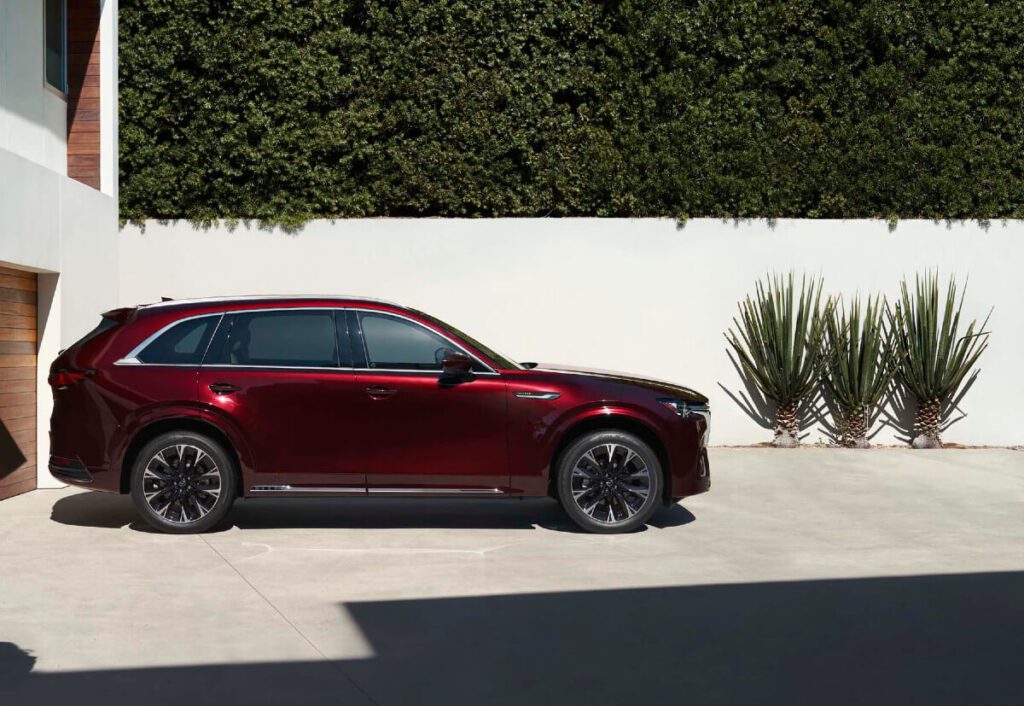
Mazda has produced two highly rated three-row SUVs as of late, so we’re comparing the Mazda CX-9 vs. CX-90 to help drivers and families determine which of these Mazda models better suits their preferences and budget.
While the first-ever 2024 Mazda CX-90 replaces the outgoing CX-9, last produced for the 2023 model year, both of these models are stellar options that motorists and families should consider when shopping for a new three-row crossover SUV with dynamic handling, efficient performance, generous dimensions, and a premium interior.
Still, you’ll likely prefer one of these Mazda three-row SUVs over the other by the end of our detailed CX-90 vs. CX-9 comparison. Keep reading to find your favorite.
Mazda CX-90 Vs. CX-9: A Comprehensive Comparison
If you’re shopping for a new or pre-owned SUV that can accommodate passengers in three rows, you may already have the new Mazda CX-90 or its predecessor, the CX-9, on your test-drive list. But we think you’ll want to consider the alternative Mazda three-row model as well.
Whether price, dimensions, style, features, or performance is your top priority, you’ll likely be weighing all of these factors when making your SUV purchase decision. That’s why we’re covering all of these critical areas when comparing the CX-9 vs. CX-90.
Mazda CX-9 Vs. Mazda CX-90: Dimensions, Specs, Features
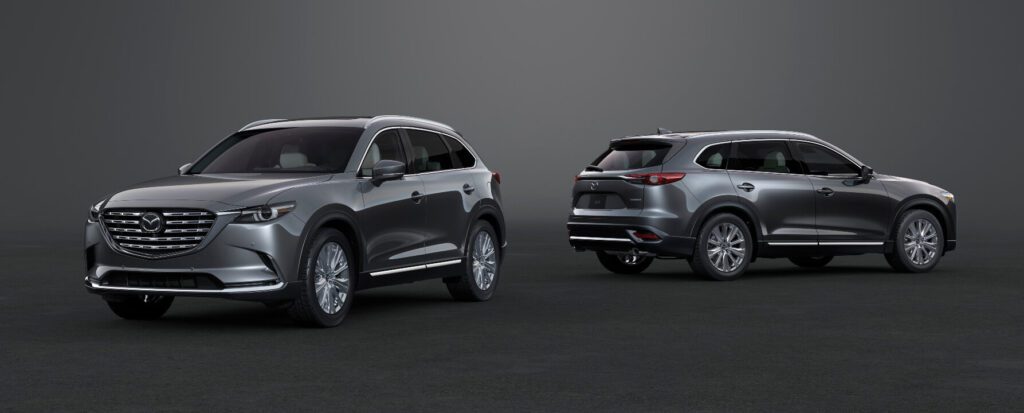
The size and dimensions of the Mazda CX-9 vs. CX-90 are a top concern of many three-row SUV shoppers, and for a good reason. The CX-9 has a reputation for having a slightly cramped third row compared to some larger models, so it’s only natural that Mazda sought to address this issue with the development of the CX-90, and SUV shoppers are curious about the results.
Since the CX-90 vs. CX-9 dimensions is a priority for many cross-shoppers of these two SUVs, let’s first address the size discrepancy between the CX-9 and CX-90 before moving on to other differences between these models.
Comparing Mazda CX-9 Vs. CX-90 Dimensions
The Mazda CX-9 measures 199.4 inches long and 77.5 inches wide. Its successor, the CX-90, is about two inches longer at 201.6 inches in length and ever-so-slightly wider at 77.6 inches in width. So, there’s not much difference when comparing the CX-9 vs. CX-90 dimensions, right?
Well, not exactly. The CX-90 vs. CX-9 length comparison doesn’t tell us everything we need to know about the size difference between these two Mazda three-row SUVs.
Simply looking at the specs sheet or even a side-by-side comparison of the CX-9 vs. CX-90 length on your local Mazda dealership lot won’t tell you the full story of how these Mazda SUVs compare in size and dimensions.
In fact, we recently did a walkaround of a Mazda CX-9 and CX-90 parked alongside one another, and they looked nearly identical in length and overall size. So it’s easy to see why SUV shoppers could assume their interiors are almost the same size, too.
But let’s look at the complete picture to better understand how these models differ in dimensions.
For starters, these two Mazda three-row SUV models greatly differ when we look at the wheelbase underpinning them. The CX-9 rides on a 115.3-inch wheelbase while the newer CX-90 sports a stretched 122.8-inch wheelbase.
Their wheelbases are one of the determining factors when comparing the CX-90 vs. CX-9 dimensions, as the CX-90 SUV’s longer wheelbase results in more generous passenger space for three rows of occupants between its front and rear wheels.
Passenger Volume, Seating Capacity, & Cargo Space
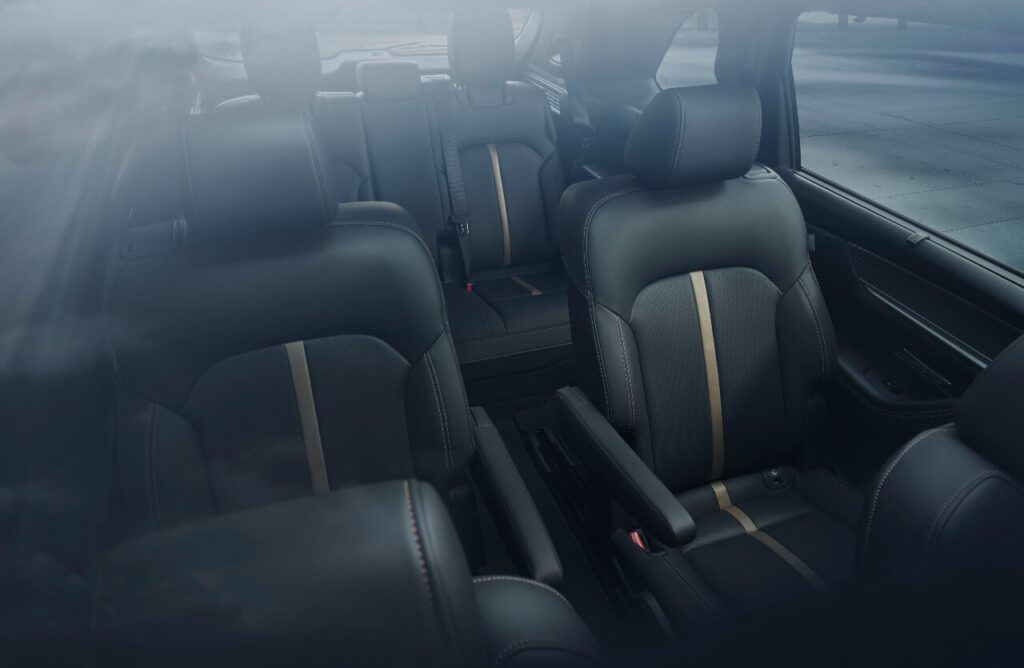
With 141.6 cubic feet of passenger volume, the Mazda CX-90 tops the CX-9 and its 135.8 cubic feet by a significant margin. The result is a CX-90 model with more first- and third-row leg room than the CX-9 it replaces.
While the second-row leg room of the CX-90 and CX-9 are identical at 39.4 inches, the larger CX-90 provides increased second-row head room compared to its predecessor, up to 39.3 inches compared to 38.5 inches.
Comparing the base models of the 2023 Mazda CX-9 vs. 2024 Mazda CX-90, we find the following differences in size and dimensions:
At a Glance: CX-9 Vs. CX-90 Dimensions
| Mazda CX-9 | Mazda CX-90 | |
| Passenger Volume | 135.8 cubic feet | 141.6 cubic feet |
| Seating Capacity | 6 or 7 | 6, 7, or 8 |
| Front Head Room | 40.1 inches | 39.7 inches |
| Front Leg Room | 41 inches | 41.7 inches |
| Second-row Head Room | 38.5 inches | 39.3 inches |
| Second-row Leg Room | 39.4 inches | 39.4 inches |
| Third-row Head Room | 35.4 inches | 36.9 inches |
| Third-row Leg Room | 29.7 inches | 30.4 inches |
| Cargo Space Behind Third Row | 14.4 cubic feet | 14.9 cubic feet |
| Cargo Space Behind Second Row | 38.2 cubic feet | 40 cubic feet |
| Cargo Space Behind First Row | 71.2 cubic feet | 74.2 cubic feet |
As you can see, the closer you look, the more the CX-90 vs. CX-9 dimensions differ. While the CX-9 vs. CX-90 length difference is negligible, the new CX-90 tops the CX-9 in key areas like cargo space, maximum passenger capacity, and third-row dimensions.
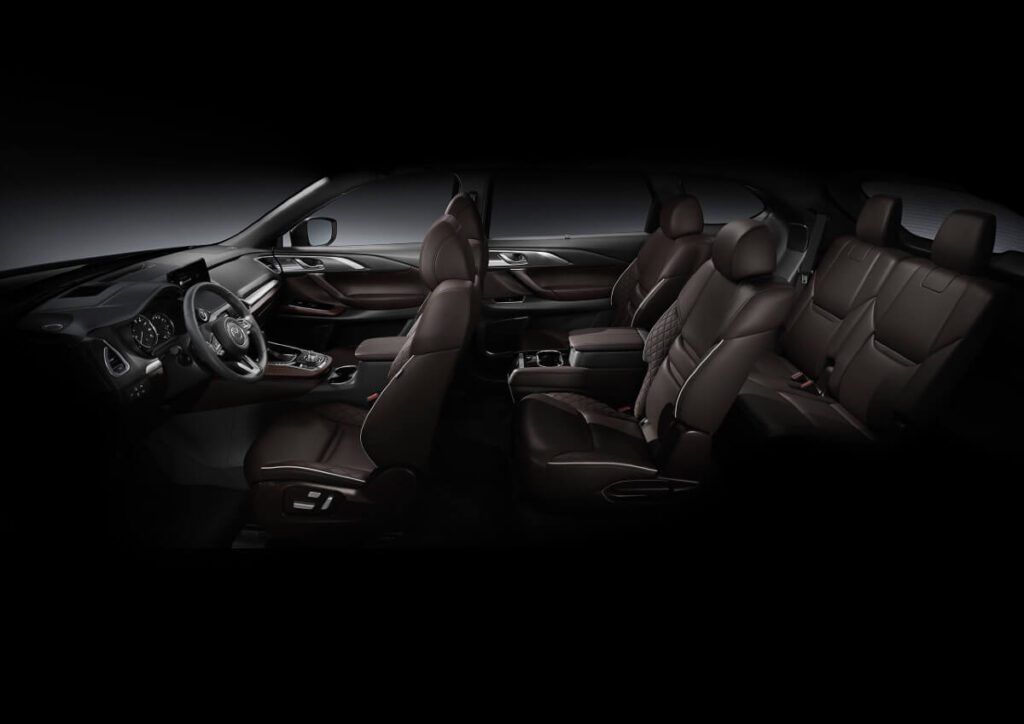
That doesn’t mean the Mazda CX-9 isn’t the right SUV for you and your crew. After all, bigger isn’t necessarily always better when it comes to three-row SUVs. Your decision might come down to how you plan to use its interior and your preferences for handling feel, where both of these Mazda SUVs excel compared to their competition.
Many motorists comment how the CX-9 drives smaller than it is. To many, it handles similar to a CX-5 compact two-row model, and unlike other three-row crossover SUVs. See our Mazda CX-9 vs. Toyota Highlander comparison for more on how the CX-9 stacks up against a more mainstream option.
The new Mazda CX-90 also offers sharp, responsive handling, but it feels a bit bigger behind the wheel. So, you’ll want to consider more than just interior volume when choosing between these Mazda SUV models.
If you plan on using the third row for occasional seating instead of nearly everyday seating and don’t mind the slightly less overall cargo capacity, the more affordable CX-9 might be your best bet. We’ll come to our Mazda CX-90 vs. CX-9 price comparison shortly, but first, let’s review the differences in these SUVs’ powertrains and performance specs.
CX-90 Vs. CX-90: Engine Specs, Performance, Efficiency
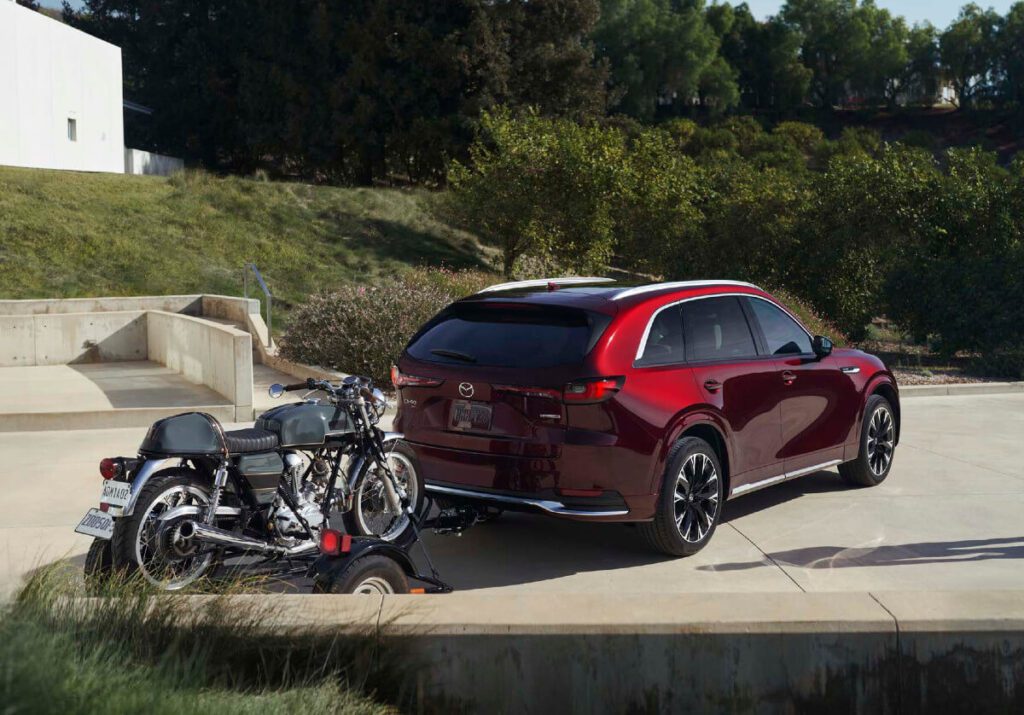
Every second-generation Mazda CX-9 is motivated by a Skyactiv-G 2.5-liter turbo-four engine producing up to 320 pound-feet of torque and 250 horsepower when burning premium fuel (310 pound-feet and 227 horsepower on regular unleaded).
Front-wheel drive was standard, with all-wheel drive available until 2022, when the CX-9 and other Mazda SUV models gained standard AWD. Power is sent to the wheels through a six-speed Skyactiv-drive automatic transmission developed by Mazda to deliver increased efficiency, smooth engagement, and a more direct and responsive feel.
The new CX-90 model replacing the CX-9 in the Mazda three-row lineup gets entirely different powertrains than its predecessor. It starts with a 280-horsepower e-Skyactiv-G 3.3-liter turbocharged inline six-cylinder engine, generating 332 pound-feet of torque.
The next available powertrain in the Mazda CX-90 engine stable is a high-output variant of the automaker’s new 3.3-liter turbo inline-six, making a maximum of 369 pound-feet of torque and 340 horsepower in the various 3.3 Turbo S trims.
Lastly, there’s the Mazda CX-90 PHEV, a plug-in hybrid variant with up to 323 horsepower and 369 pound-feet of torque. Instead of six cylinders, the CX-90 PHEV utilizes an e-Skyactiv-G 2.5 four-cylinder featuring an electric motor.
All CX-90 models come equipped with the carmaker’s new eight-speed Skyactiv-Drive automatic coupled with engines that perform at peak power and efficiency on premium fuel. While premium gas is recommended, the new CX-90 SUVs can run on regular, too.
How about CX-9 vs. CX-90 fuel economy? The new CX-90 SUVs offer a more fuel-efficient lineup, with an EPA-estimated 24 city and 28 highway MPG with the base powertrain and increasing with the PHEV model. The CX-9 manages an EPA-estimated 20 city and 26 highway MPG in its latest model year.
Driver Assistance & Safety Technology
You won’t find too many differences in the safety tech and driver-assist features on the Mazda CX-90 vs. CX-9, and that’s a great thing.
Both models feature Mazda’s i-Activsense suite of advanced driver aids including:
- Advanced Smart City Brake Support
- Mazda Radar Cruise Control
- Blind Spot Monitoring
- Driver Attention Alert
- Traffic Sign Recognition
- Lane Departure Warning System
- Lane-Keep Assist
- Adaptive Front-Lighting System
- Rear Cross Traffic Alert
- High Beam Control
Still, the next-generation Mazda three-row SUV, the CX-90, adds newly available tech never offered on the outgoing CX-9, like:
- Emergency Lane Keeping
- Secondary Collision Reduction System
- Rear seat alert
- Front and rear parking sensors
Mazda CX-9 Vs. CX-90 Price Comparison
The next-gen Mazda CX-90 is the pricier of the two models, with a starting MSRP of $39,595 for the 2024 model and peaking at a $59,950 MSRP for the top-trim 3.3 Turbo S Premium Plus.
If you’re interested in plug-in-hybrid power, the 2024 Mazda CX-90 PHEV price starts at $47,445 and reaches $56,950 in its top trim.
Comparing the CX-90 vs. CX-9 price, you’ll find that the final year of the CX-9, 2023, brought a starting MSRP of $38,750, with the range-topping trim CX-9 Signature fetching a $48,460 MSRP.
Of course, finding a late-model Mazda CX-9 on the pre-owned market could further increase the cost advantage of the older model. We’ll have to wait to see how the first-year 2024 CX-90 prices hold compared to 2023 CX-9 prices as both models start arriving on used car lots.
CX-9 Vs. CX-90 Size, Specs, Features: Final Thoughts

Choosing between the Mazda CX-9 vs. CX-90 can be challenging, as these models are similarly sized and equipped, save for a few significant differences. Your choice will be easier if you’re only shopping for a brand-new Mazda three-row SUV, but if not, the CX-9 is still a tempting alternative to the fresh-faced and highly modern CX-90.
But for more space, more premium tech, and greater fuel economy, the new Mazda CX-90 is the way to go.
Now that we’ve compared the CX-90 vs. CX-9 size, dimensions, engine, specs, safety tech, and pricing, which model has jumped to the top of your test drive list?
We’ll be bringing you more reviews and comparisons of the latest Mazda crossover SUVs, hybrid models, and hopefully some yet-to-be-released Mazda sports cars and performance models. Stay tuned and subscribe to MazdaMotoring below for updates.
Join Our Newsletter
Never miss a Mazda when you sign up for our email list:
Frequently Asked Questions
Is the Mazda CX-90 replacing the CX-9?
Yes, the first-ever Mazda CX-90 is replacing the CX-9 in the Mazda lineup as the automaker’s three-row SUV. The final year of the Mazda CX-9 is 2023, while the all-new CX-90 debuted for the 2024 model year. Since the 2024 CX-90 arrived in 2023, the models were sold alongside each other until the 2023 CX-9 ceased production.
Which is bigger: the Mazda CX-9 or CX-90?
The Mazda CX-90 is bigger than the Mazda CX-9, as it measures 201.6 inches long compared to the CX-9 at 199.4 inches long. At over two inches longer than the CX-9, the new Mazda CX-90 looks and feels bigger inside and out. See these two models side by side and get inside both to compare them for yourself.
Which has better fuel economy: the Mazda CX-9 or CX-90?
The Mazda CX-90 lineup offers better fuel economy than the CX-9, thanks to the mild hybrid and plug-in hybrid setups available in the all-new CX-90. The Mazda CX-90 base engine achieves up to an EPA-estimated 24 city and 28 highway MPG, while the CX-9 earns up to an EPA-estimated 20 city and 26 highway MPG. The CX-90 PHEV fuel economy is even greater, thanks to its new plug-in hybrid powertrain.
Which has more passenger volume: the Mazda CX-90 or CX-9?
The Mazda CX-90 has significantly more passenger space than the CX-9. Drivers and up to eight occupants can enjoy up to 141.6 cubic feet of passenger volume in the new CX-90. The slightly smaller CX-9 offers 135.8 cubic feet of passenger space, including a little less third-row leg room than the CX-90.

